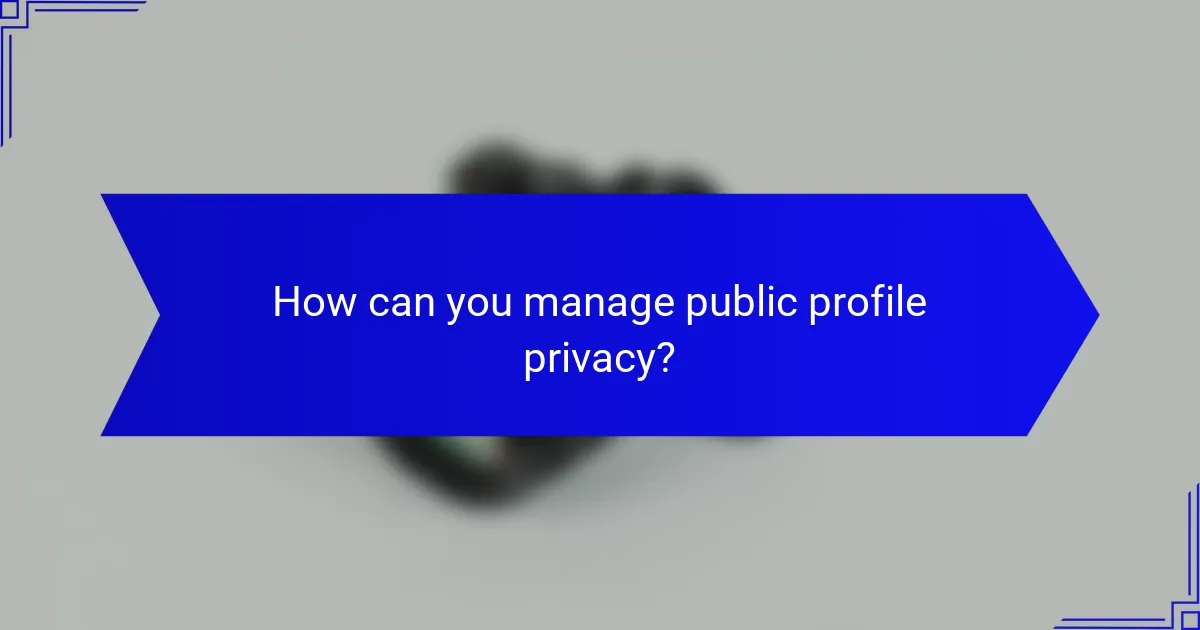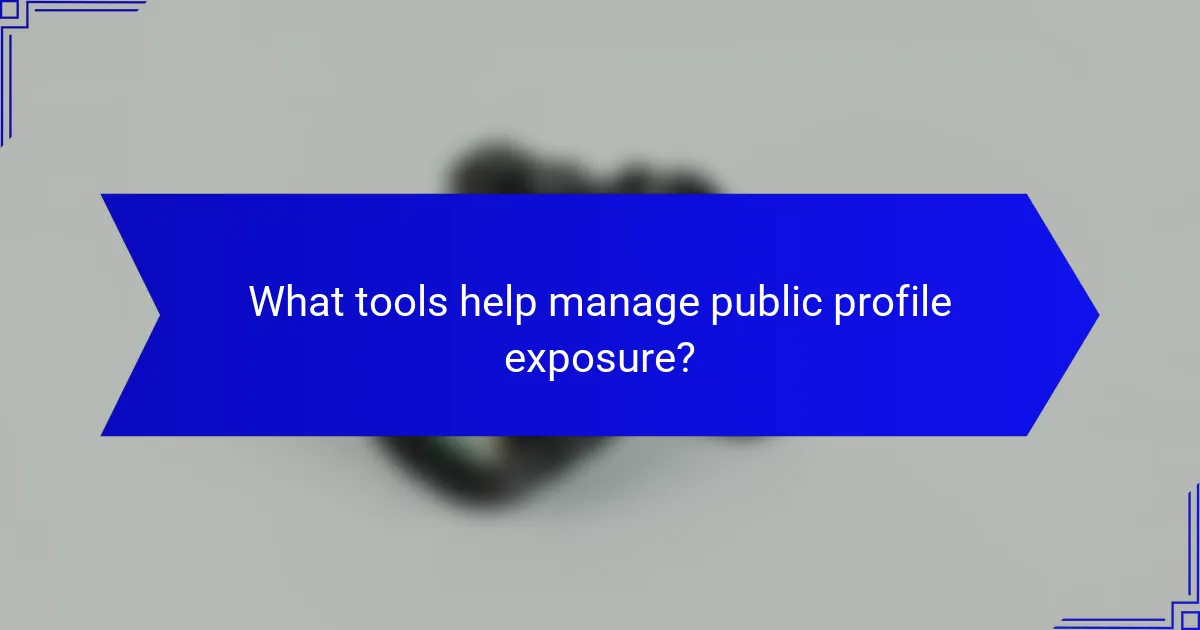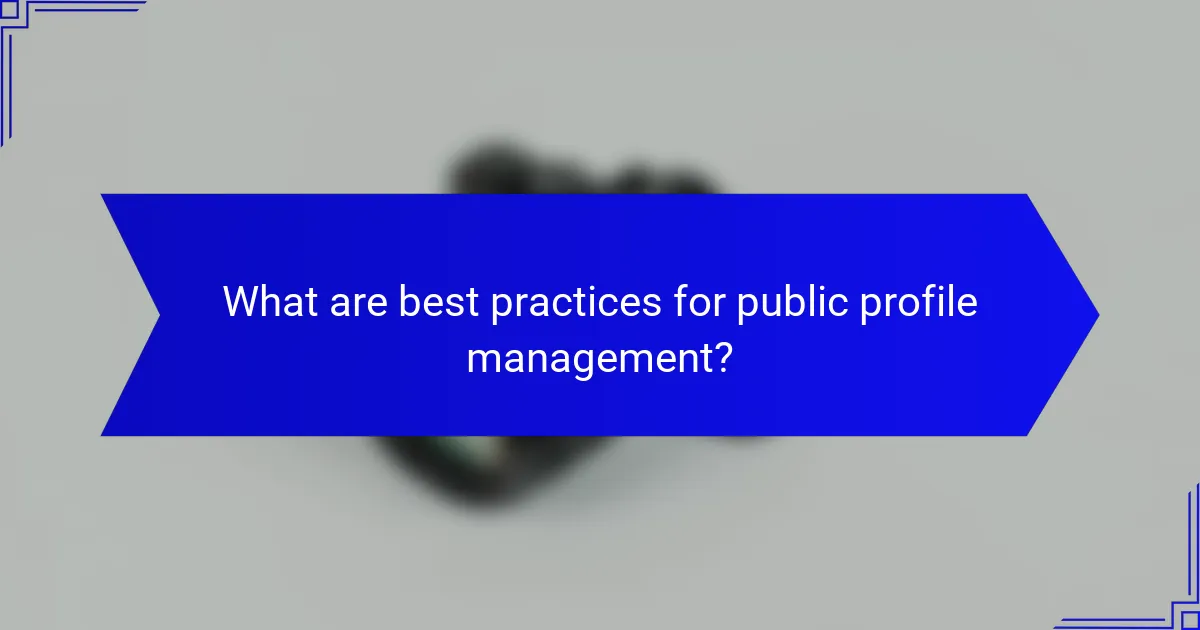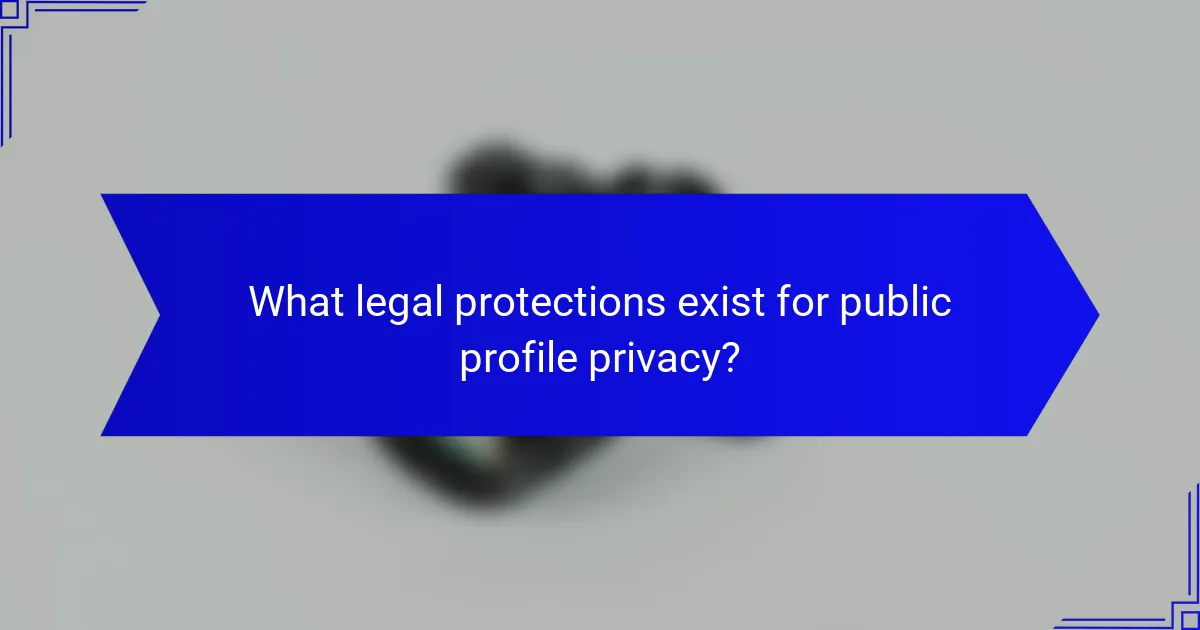Public profiles in the digital age present significant risks, including privacy invasion and potential identity theft. It is crucial for users to understand how their information can be accessed and misused, prompting the need for proactive management of their online presence. By adjusting privacy settings and utilizing protective tools, individuals can effectively safeguard their personal data and maintain a positive reputation.

What are the risks of public profiles in the United States?
Public profiles in the United States pose several risks, including privacy invasion, identity theft, and reputation damage. Users must be aware of how their information can be accessed and misused by others.
Privacy invasion
Privacy invasion occurs when personal information shared on public profiles is accessed by unauthorized individuals. This can lead to unwanted attention, harassment, or even stalking, as sensitive details about a person’s life become easily available.
To mitigate privacy risks, users should regularly review their privacy settings on social media platforms and limit the amount of personal information shared publicly. Consider using pseudonyms or restricting profile visibility to trusted contacts.
Identity theft
Identity theft is a significant risk associated with public profiles, as criminals can gather enough personal information to impersonate someone. This can result in financial loss, damage to credit scores, and legal issues for the victim.
To protect against identity theft, avoid sharing sensitive information such as your full name, birth date, and address on public profiles. Regularly monitor financial accounts and credit reports for any suspicious activity.
Reputation damage
Reputation damage can occur when negative information or images are associated with a person’s public profile. This can affect personal relationships, job prospects, and overall social standing.
To manage reputation risks, be cautious about the content you post and engage with online. Regularly search for your name to see what information is publicly available and take steps to remove or report any damaging content.

How can you manage public profile privacy?
Managing public profile privacy involves taking proactive steps to control what information is visible to others. By adjusting settings, limiting shared details, and using pseudonyms, you can significantly reduce your exposure online.
Adjust privacy settings
Most social media platforms and online services offer privacy settings that allow you to control who can see your profile and posts. Regularly review these settings to ensure they align with your privacy preferences. For example, you can set your profile to private, limiting access to only approved friends or followers.
Consider enabling features like two-factor authentication for added security. This helps protect your account from unauthorized access, which is crucial for maintaining your privacy.
Limit personal information shared
Be mindful of the personal information you share on your public profile. Avoid including sensitive details such as your home address, phone number, or financial information. Instead, share only what is necessary and relevant to your online interactions.
When posting updates or photos, think about the potential audience. Limit the amount of identifiable information in your posts, and consider using general terms instead of specific locations or events that could reveal too much about your life.
Use pseudonyms
Using a pseudonym can help protect your identity online while still allowing you to engage with others. Choose a name that does not directly relate to your real identity, making it harder for others to trace your online activities back to you.
However, be cautious with pseudonyms as some platforms may require real names for account verification. Always check the terms of service to ensure you remain compliant while maintaining your privacy.

What tools help manage public profile exposure?
Managing public profile exposure involves using various tools designed to enhance privacy, control online reputation, and protect personal data. These tools can help individuals navigate the complexities of maintaining a secure and positive online presence.
Privacy-focused social media platforms
Privacy-focused social media platforms prioritize user data protection and limit exposure to unwanted audiences. Examples include platforms like MeWe and Minds, which offer features such as end-to-end encryption and minimal data collection.
When choosing a privacy-centric platform, consider the level of control you have over your data and the audience settings available. It’s essential to review the platform’s privacy policy to understand how your information is handled.
Reputation management services
Reputation management services help individuals and businesses monitor and improve their online image. These services typically include tracking mentions, removing negative content, and promoting positive information across search engines and social media.
When selecting a reputation management service, assess their track record and the strategies they employ. Some services may offer monthly subscriptions, while others charge based on the scope of work, so consider your budget and specific needs.
Data protection software
Data protection software safeguards personal information from unauthorized access and breaches. This software often includes features like encryption, secure file storage, and identity theft protection.
Look for data protection solutions that comply with relevant regulations, such as GDPR or CCPA, depending on your location. Regularly updating your software and using strong, unique passwords can further enhance your data security.

What are best practices for public profile management?
Best practices for public profile management involve regularly updating privacy settings, monitoring your online presence, and educating yourself about potential threats like phishing attacks. By actively managing these aspects, you can significantly reduce risks associated with privacy and exposure.
Regularly review privacy settings
Regularly reviewing your privacy settings is crucial for protecting your personal information. Most social media platforms and online services offer customizable privacy options that allow you to control who can see your profile, posts, and personal details.
Consider adjusting settings to limit visibility to friends only or specific groups. Regular checks, ideally every few months, ensure that any changes in platform policies or features do not compromise your privacy.
Monitor online presence
Monitoring your online presence helps you stay aware of what information about you is publicly accessible. Use search engines to periodically check your name and see what appears; this can reveal outdated or unwanted information.
Consider setting up Google Alerts for your name or other identifying details. This way, you can receive notifications when new content is published that includes your information, allowing you to take action if necessary.
Educate about phishing attacks
Understanding phishing attacks is essential for protecting your public profile from unauthorized access. Phishing typically involves deceptive emails or messages that trick you into providing personal information or clicking on malicious links.
Stay informed about common phishing tactics, such as fake login pages or urgent requests for personal data. Always verify the source of messages before responding or clicking on links, and consider using two-factor authentication for added security.

What legal protections exist for public profile privacy?
Legal protections for public profile privacy vary by region and can significantly impact how personal information is handled. Key regulations like the GDPR and CCPA provide frameworks for individuals to control their data and seek recourse in case of violations.
GDPR compliance
The General Data Protection Regulation (GDPR) is a comprehensive privacy law in the European Union that protects individuals’ personal data. It grants rights such as the right to access, rectify, and erase personal information, ensuring that organizations handle data transparently and securely.
Under GDPR, individuals must give explicit consent for their data to be processed, and they can withdraw this consent at any time. Organizations face significant fines for non-compliance, which can reach up to 4% of their annual global turnover or €20 million, whichever is higher.
California Consumer Privacy Act (CCPA)
The California Consumer Privacy Act (CCPA) enhances privacy rights for California residents, allowing them to know what personal data is collected and how it is used. Consumers have the right to request the deletion of their data and to opt out of its sale to third parties.
Businesses must provide clear notices about data collection practices and comply with consumer requests within specific timeframes. Non-compliance can result in fines up to $7,500 per violation, emphasizing the importance for businesses to prioritize consumer privacy.

How do cultural attitudes affect public profile risks?
Cultural attitudes significantly influence how individuals perceive and manage public profile risks, including privacy and exposure. In societies with a high value on privacy, individuals may be more cautious about sharing personal information, while in cultures that prioritize openness, there may be a greater willingness to share details publicly.
Varied privacy expectations
Privacy expectations can differ widely across cultures, impacting how individuals approach their public profiles. For instance, in some European countries, stringent data protection laws like GDPR reflect a strong cultural emphasis on personal privacy, leading individuals to be more protective of their information.
In contrast, cultures that embrace social networking and public sharing, such as in parts of the United States, may encourage individuals to maintain more open profiles. This can result in a higher risk of exposure, as people may not fully consider the implications of sharing personal details online.
To navigate these varied expectations, individuals should assess their cultural context and adjust their privacy settings accordingly. Understanding local norms can help in making informed decisions about what information to share and how to manage public profiles effectively.
